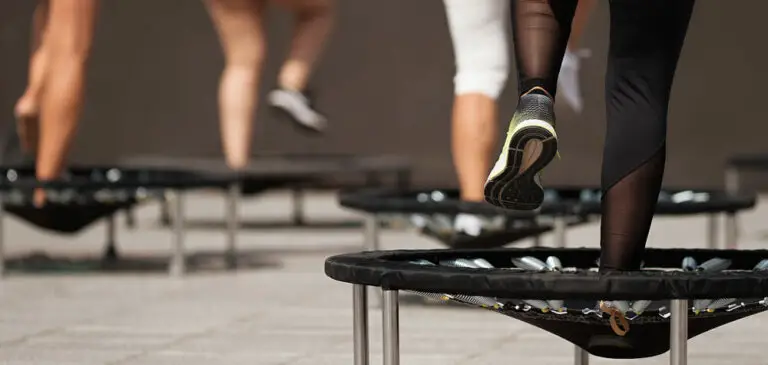Trampolines are a fun backyard staple for both kids and adults. Their bouncy surface provides hours of entertainment and exercise. But with all the jumping action, an important question arises – how much weight can a trampoline actually hold?
The maximum weight capacity of a trampoline depends on several key factors. These include the size, shape, materials used, and manufacturing quality. In this article we will deep dive at the crucial elements that allow a trampoline to safely bear weight, support multiple users, and withstand the repeated impact of jumping without failing.
Why Trampoline Weight Limits are Important
Trampolines are designed and tested to meet certain weight limit specifications for good reason. Adhering to the recommended capacity guidelines is essential for safety, performance, and longevity.
- Exceeding the stated weight limit poses serious potential safety hazards. The excessive stress could lead to injury from falls due to component failures, reduced bounce control, and instability. Staying within the manufacturer’s guidelines helps minimize these risks.
- Proper functioning of the interconnected trampoline parts like mats, springs, frames depends on remaining within design load tolerances. Using the trampoline as intended by respecting weight limits helps ensure optimal bounce, shock absorption, and structural integrity.
- The durability and lifespan of a trampoline depends heavily on avoiding overloading. Gradual frame bending, spring stretching, and mat deterioration will occur over time with excessive weight. Adhering to limits preserves quality and extends usage.
- Weight capacities factor in simultaneous users, dynamic motion, and peak impact forces, not just static load. Although trampolines may withstand more weight when stationary, the forces generated by jumping near the limit frequently leads to premature fatigue and failure.
- Exceeding stated weight limits typically voids manufacturer warranties. This transfers repair and replacement costs to the consumer in the event of damage attributed to overloading.
Trampoline weight limits represent thoroughly tested thresholds that should not be exceeded. This helps ensure the safety of users, preserves optimal function, and prevents premature breakdown – ultimately getting your money’s worth from the investment. So be sure to check and follow the limits.
How Much Weight Can a Trampoline Hold?
The amount of weight a trampoline can safely hold depends on several factors, including the size, shape, quality of materials, and manufacturer specifications. Standard round trampolines made for home use typically have weight limits ranging from about 150 pounds for smaller models up to 250-350 pounds for full-sized options. Some high-end consumer trampolines may be rated to hold upto 450 pounds.

Rectangular trampolines are engineered to handle even greater loads safely upto 800 pounds. This increased capacity is thanks to their shape and additional springs distributing force more effectively. It’s important to note that stated limits account for total load with multiple users. Check manufacturer guidelines for your specific trampoline model’s tested capacity and do not exceed it to minimize injury and failure risk from overloading.
What Determines a Trampoline’s Weight Limit
The maximum weight capacity of a trampoline depends on several key factors relating to its design, components, and construction. Understanding what influences the weight limit can help guide you in choosing a trampoline suitable for your needs.
Size and Shape
The size and shape of the trampoline mat play a major role in determining potential weight limits.
- Larger trampolines distribute force over more springs and a bigger jumping surface area, allowing for higher weight capacities. A standard 15 ft round trampoline can hold more weight than a small 7 ft toddler version.
- Rectangular or oval trampolines are engineered to handle greater loads than round trampolines of equal mat size. The shape and additional springs increase stability for multiple jumpers.
Materials Used
The quality and thickness of materials used for key components also affect the overall weight limit:
- Thicker, galvanized steel tubing in the frame provides more strength and resistance to bending under heavy loads.
- Higher tension springs with conical ends have greater shock absorption before over-extension. More springs spread force better.
- Commercial-grade mats withstand repeated impact without tearing or excessive stretching compared to budget mats.
Manufacturing Standards
- Brands with stricter quality control standards rate their trampolines more conservatively to ensure safety and longevity.
- Budget trampolines may push weight limits in their marketing without the same safety testing protocols.
- Materials, construction methods, and country of origin results in quality differences between brands.
In summary, larger size, premium materials, robust frames, many springs, and reputable brands result in higher weight rated trampolines. Considering these key factors helps ensure you choose a trampoline designed to safely handle your weight needs.
Average Weight Capacity of Trampoline
The maximum weight a trampoline can safely support varies based on factors like size, shape, quality, and materials. Here are some general guidelines for average capacity:
By Size
- Smaller toddler trampolines under 5 ft: 75-100 lbs
- Kids trampolines 5-8 ft: 100-150 lbs
- Medium trampolines 10-12 ft: 200-300 lbs
- Full-size trampolines 12-15 ft: 250-350 lbs
- Large trampolines over 15 ft: Up to 500 lbs
By Shape
- Round: 150-350 lbs
- Rectangular: 250-850 lbs
- Oval: 300-600 lbs
By Style
- With enclosure net: Reduce capacity by ~50 lbs
- Without enclosure: Higher capacity
- Bungee vs spring: Similar average capacity
By Materials
- Budget quality: Towards lower end of range
- Premium quality: Towards higher end of range
- Thicker steel, more springs: Increased capacity
In short, larger size, rectangular shape, premium materials and a reputable brand generally equate to higher average trampoline weight limits, while smaller size, circular shape and budget materials reduce capacity.
How does proper maintenance make impact on Trampoline’s Weight limits?
Performing regular maintenance and care for your trampoline helps preserve its weight capacity and extend its usable lifespan. Proper maintenance is key for safety and performance.
Regular Inspection and Replacement of Damaged Parts
- Check for any signs of wear, fraying, stretching, rust, or damage. Replace springs, mats, or frames promptly as needed.
- Worn out components like deteriorated mats or weakened springs reduce the safe working loads and can lead to failures under normal use if not replaced.
Proper Spring Tensioning and Attachment
- Make sure springs are securely attached and maintain proper tension. Loss of tension reduces shock absorption.
- Replace any missing, damaged, or overstretched springs that could contribute to failures when landing.
Cleaning and Care of Mat
- A dirty mat degrades more quickly from abrasion and environmental exposure. Regular cleaning maximizes mat life.
- Check for mat tears, holes, or thin spots that can continue spreading under repeated bouncing stress.
Anchoring and Nets for Safety
- Securely anchor the trampoline frame to prevent shifting. This maintains stability under load.
- Install protective net enclosures to prevent falls and injuries that could damage the components.
Avoidance of Hazards Around Trampoline
- Keep areas around the trampoline clear to prevent falls onto dangerous surfaces that could damage the frame or mat.
- Eliminate any nearby hazards that could cause injury and lead to premature wear from improper use.
In summary, carefully maintaining your trampoline helps ensure it retains its structural integrity to safely handle users up to the stated weight limit over its full lifetime.
Choosing the Right Weight Limit Trampoline
When selecting a new trampoline, it’s important to consider the weight limit to ensure it suits your needs both now and in the future. Here are some tips for choosing the right capacity:
Consider Current and Future Users
- Account for the ages, sizes, and number of people likely to use the trampoline. This determines the basic weight needs.
- Allow room for kids to grow over the years to avoid exceeding limits as their size and weight increase with age.
- Factor in potential adult use too, even if primarily meant for children. Their higher weight impacts limits.
Purchase Higher Limit Than Currently Needed
- Buy a trampoline with a significantly higher published weight limit than your collective weight. This provides a buffer.
- Getting a trampoline rated for more weight than you strictly need right now allows room to grow over time.
- You can avoid frequently replacing the trampoline as kids get bigger and new users are added.
Compare Weight Limits Across Brands
- Similar sized trampoline models from different brands may have varying weight limits.
- Check the specs carefully, as marketing claims may exaggerate capacities without safety testing.
- Higher quality materials and manufacturing standards generally equate to higher true weight limits.
Consider Total Weight Distribution
- The number of simultaneous jumpers affects limits as total weight is spread across the mat.
- Use reasonable judgment – a “350 pound” trampoline is not meant for 4 average adults exceeding 350 pounds combined.
- Distribute total user weight evenly across the mat for optimal performance and safety.
In summary, carefully consider current and future needs, quality, brands, and number of users when selecting a trampoline with the right weight limit for your household. This ensures a long-lasting, safe investment.
What Happens If You Exceed the Weight Limit?
Exceeding the recommended weight limit on a trampoline can lead to serious consequences that impact safety and performance. It is crucial to adhere to the maximum weight capacity set by the manufacturer to avoid potential hazards.
- There is an increased risk of injury if you overload the trampoline beyond the specifications. The excessive weight can cause equipment failure as key components become overstressed. For example, the jumping mat may tear or the frame could bend or collapse if too much force is repeatedly applied.
- The springs on the trampoline are designed to provide optimal bounce up to a certain weight limit. When overloaded, the springs can become overextended and snap. A greater than recommended weight also leads to reduced bounce performance as the springs lose their tension and shock absorption capacity.
- Most trampoline brands will void the warranty if you exceed the stated weight limit. The product is only guaranteed up to the specified maximum capacity, so going over this threshold often absolves the manufacturer of responsibility in case of any damage or failures.
- The effects of overload may happen immediately in a dramatic way, like the frame buckling suddenly. But exceeding the weight limit can also cause gradual wear and tear that reduces the trampoline’s lifespan and deteriorates the quality and safety over time.
- The consequences will be more severe the more you go over the recommended capacity. For example, a 150 pound person using a trampoline rated for 250 pounds may only experience slightly reduced bounce. But a 400 pound adult on the same trampoline could lead to catastrophic failure and injury.
- Rectangular or oval-shaped trampolines often have a higher weight limit than circular ones of the same size. The shape and additional springs distribute weight better. But exceeding the maximum capacity on any shape or size of the trampoline comes with risks.
It is vital to stay within the recommended weight limit for your particular trampoline model. Overloading beyond this threshold strains the components, reduces safety, impacts performance, and voids the warranty. Checking the specifications and not exceeding the tested maximum capacity helps ensure the longevity and integrity of your trampoline investment.
Conclusion
Trampolines can provide years of fun and exercise when used properly within the advised weight limits. As we’ve explored, weight capacity depends on key factors like size, shape, materials, and quality. Exceeding manufacturer guidelines strains components and poses serious risks.
By understanding what determines trampoline weight limits, regularly inspecting for damage, and performing preventative maintenance, you can maximize safety, durability, and return on investment. When in doubt, always defer to the manufacturer’s tested capacity for your model. Following recommendations helps the whole family enjoy jumping without worrying about damage or injuries from overloading.
{ “@context”: “https://schema.org”, “@type”: “FAQPage”, “mainEntity”: [ { “@type”: “Question”, “name”: “What is the Weight Limit for a 15 Ft Trampoline?”, “acceptedAnswer”: { “@type”: “Answer”, “text”: “A 15 ft trampoline typically has a weight limit of 350-450 lbs. This weight limit is in place to ensure the safety of the user and to prevent the trampoline from being damaged. It is important to note that the weight limit may vary depending on the manufacturer and model of the trampoline.” } }, { “@type”: “Question”, “name”: “What is the load limit for a 16-foot trampoline?”, “acceptedAnswer”: { “@type”: “Answer”, “text”: “A 16-foot trampoline can typically hold a weight limit of around 400-450 pounds. However, it is crucial to refer to the manufacturer’s product recommendation and guidelines to ensure the trampoline is used safely within its weight capacity.” } }, { “@type”: “Question”, “name”: “What is the American Society for Testing and Materials (ASTM) requirement for trampoline weight limits?”, “acceptedAnswer”: { “@type”: “Answer”, “text”: “The ASTM requires trampolines to withstand four times the weight limit during testing. This ensures that the trampoline can handle a significant weight load without compromising its structural integrity and user safety.” } }, { “@type”: “Question”, “name”: “How Much Weight can a Propel Trampoline hold?”, “acceptedAnswer”: { “@type”: “Answer”, “text”: “Propel trampolines have different weight limits depending on the size of the trampoline. According to the manufacturer’s website, the Propel trapoline can hold from 150 pounds to 300 pounds on average depending on the specific model.” } }, { “@type”: “Question”, “name”: “How Much Weight can a Skywalker Trampoline hold?”, “acceptedAnswer”: { “@type”: “Answer”, “text”: “The weight limit of a Skywalker trampoline can vary depending on the type of trampoline and the specific brand. According to the Skywalker Trampolines website, they can hold from 60 pounds to 625 pounds depending on the specific model.” } }, { “@type”: “Question”, “name”: “How Much Weight Can a 10Ft Trampoline Hold?”, “acceptedAnswer”: { “@type”: “Answer”, “text”: “In general, a 10 ft trampoline can hold between 200-250+ pounds. However, it is important to note that the weight limit of a trampoline can vary depending on the brand and model.” } }, { “@type”: “Question”, “name”: “How Much Weight Can a 14Ft Trampoline Hold?”, “acceptedAnswer”: { “@type”: “Answer”, “text”: “The weight limit of a 14 ft trampoline can vary depending on the brand and model. But most of cases, the weight limit for a 14 ft trampoline is generally between 350 lbs to 475 lbs.” } }, { “@type”: “Question”, “name”: “How Much Weight Can a Little Tikes Trampoline Hold?”, “acceptedAnswer”: { “@type”: “Answer”, “text”: “Little Tikes trampolines have different weight limits depending on the model. Here are the weight limits for some of the Little Tikes trampolines: Little Tikes 3-Foot Trampoline: up to 55lbs. Little Tikes Climb ‘n Slide 7ft. Trampoline: up to 105lbs.” } } ] }





